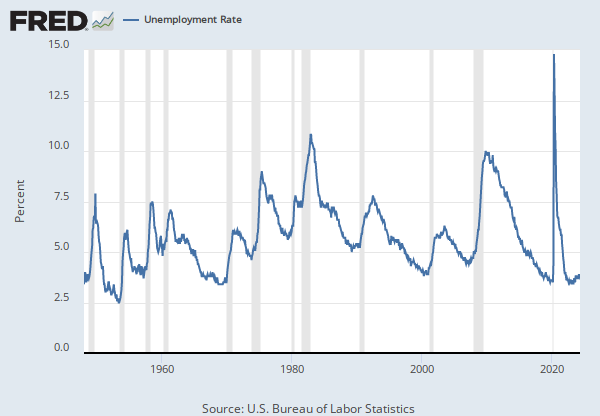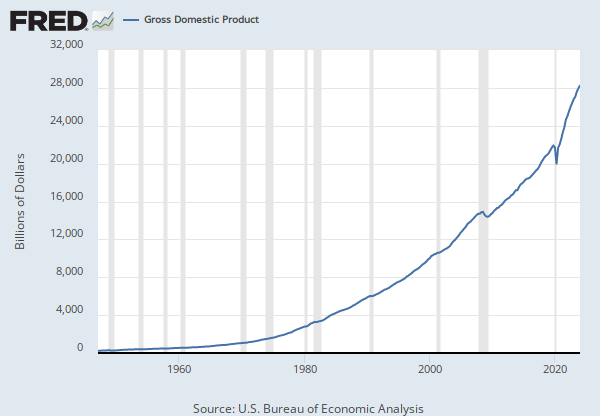Federal Reserve Economic Data
Data in this graph are copyrighted. Please review the copyright information in the series notes before sharing.
Notes
Source: U.S. Bureau of Economic Analysis
Release: Gross Domestic Product
Units: Percent Change from Preceding Period, Seasonally Adjusted Annual Rate
Frequency: Quarterly
Notes:
BEA Account Code: A191RL
Gross domestic product (GDP) is the value of the goods and services produced by the nation's economy less the value of the goods and services used up in production. GDP is also equal to the sum of personal consumption expenditures, gross private domestic investment, net exports of goods and services, and government consumption expenditures and gross investment. Real values are inflation-adjusted estimates—that is, estimates that exclude the effects of price changes.
For more information about this series, please visit the Bureau of Economic Analysis.
Suggested Citation:
U.S. Bureau of Economic Analysis, Real Gross Domestic Product [A191RL1Q225SBEA], retrieved from FRED, Federal Reserve Bank of St. Louis; https://fred.stlouisfed.org/series/A191RL1Q225SBEA, .
Source: U.S. Census Bureau
Source: U.S. Department of Housing and Urban Development
Release: New Residential Construction
Units: Thousands of Units, Seasonally Adjusted Annual Rate
Frequency: Monthly
Notes:
As provided by the Census, start occurs when excavation begins for the footings or foundation of a building. All housing units in a multifamily building are defined as being started when this excavation begins. Beginning with data for September 1992, estimates of housing starts include units in structures being totally rebuilt on an existing foundation.
Suggested Citation:
U.S. Census Bureau and U.S. Department of Housing and Urban Development, New Privately-Owned Housing Units Started: Total Units [HOUST], retrieved from FRED, Federal Reserve Bank of St. Louis; https://fred.stlouisfed.org/series/HOUST, .
Source: Board of Governors of the Federal Reserve System (US)
Release: G.17 Industrial Production and Capacity Utilization
Units: Index 2017=100, Seasonally Adjusted
Frequency: Quarterly
Notes:
The Federal Reserve's monthly index of industrial production and the related capacity indexes and capacity utilization rates cover manufacturing, mining, and electric and gas utilities. The industrial sector, together with construction, accounts for the bulk of the variation in national output over the course of the business cycle. The industrial detail provided by these measures helps illuminate structural developments in the economy. The industrial production (IP) index measures the real output of all relevant establishments located in the United States, regardless of their ownership, but not those located in U.S. territories. For more information, see the explanatory notes issued by the Board of Governors. For recent updates, see the announcements issued by the Board of Governors.
Suggested Citation:
Board of Governors of the Federal Reserve System (US), Industrial Production: Total Index [IPB50001SQ], retrieved from FRED, Federal Reserve Bank of St. Louis; https://fred.stlouisfed.org/series/IPB50001SQ, .
Source: Board of Governors of the Federal Reserve System (US)
Release: G.17 Industrial Production and Capacity Utilization
Units: Percent, Seasonally Adjusted
Frequency: Quarterly
Notes:
The Federal Reserve Board constructs estimates of capacity and capacity utilization for industries in manufacturing, mining, and electric and gas utilities. For a given industry, the capacity utilization rate is equal to an output index (seasonally adjusted) divided by a capacity index. The Federal Reserve Board's capacity indexes attempt to capture the concept of sustainable maximum output -- the greatest level of output a plant can maintain within the framework of a realistic work schedule, after factoring in normal downtime and assuming sufficient availability of inputs to operate the capital in place.
The Federal Reserve's monthly index of industrial production and the related capacity indexes and capacity utilization rates cover manufacturing, mining, and electric and gas utilities. The industrial sector, together with construction, accounts for the bulk of the variation in national output over the course of the business cycle. The industrial detail provided by these measures helps illuminate structural developments in the economy. The industrial production (IP) index measures the real output of all relevant establishments located in the United States, regardless of their ownership, but not those located in U.S. territories. For more information, see the explanatory notes issued by the Board of Governors. For recent updates, see the announcements issued by the Board of Governors.
Suggested Citation:
Board of Governors of the Federal Reserve System (US), Capacity Utilization: Total Index [CAPUTLB50001SQ], retrieved from FRED, Federal Reserve Bank of St. Louis; https://fred.stlouisfed.org/series/CAPUTLB50001SQ, .
Release Tables
- Industrial Production and Capacity Utilization: Summary: Quarterly, Seasonally Adjusted
- Industrial Production Indexes: Market and Industry Group: Quarterly, Seasonally Adjusted
- Capacity Utilization: Quarterly, Seasonally Adjusted
- Table 1.1.1. Percent Change From Preceding Period in Real Gross Domestic Product: Quarterly
- Table 1.1.2. Contributions to Percent Change in Real Gross Domestic Product: Quarterly
- Table 1.2.1. Percent Change From Preceding Period in Real Gross Domestic Product by Major Type of Product: Quarterly
- Table 1.2.2. Contributions to Percent Change in Real Gross Domestic Product by Major Type of Product: Quarterly
- Table 1.3.1. Percent Change From Preceding Period in Real Gross Value Added by Sector: Quarterly
- Table 1.4.1. Percent Change From Preceding Period in Real Gross Domestic Product, Real Gross Domestic Purchases, and Real Final Sales to Domestic Purchasers: Quarterly
- Table 1.5.1. Percent Change From Preceding Period in Real Gross Domestic Product, Expanded Detail: Quarterly
- Table 1.5.2. Contributions to Percent Change in Real Gross Domestic Product, Expanded Detail: Quarterly
- Table 1.7.1. Percent Change from Preceding Period in Real Gross Domestic Product, Real Gross National Product, and Real Net National Product: Quarterly
- Table 1.8.3. Command-Basis Real Gross Domestic Product and Gross National Product, Quantity Indexes: Quarterly
- Table 1.17.1. Percent Change From Preceding Period in Real Gross Domestic Product, Real Gross Domestic Income, and Other Major NIPA Aggregates: Quarterly
Related Data and Content
Data Suggestions Based On Your Search
Content Suggestions
Other Formats
Real Gross Domestic Product
Billions of Chained 2017 Dollars, Annual, Not Seasonally Adjusted Billions of Chained 2017 Dollars, Quarterly, Not Seasonally Adjusted Billions of Chained 2017 Dollars, Quarterly, Seasonally Adjusted Annual Rate Index 2017=100, Quarterly, Not Seasonally Adjusted Annual, Not Seasonally Adjusted Percent Change from Quarter One Year Ago, Quarterly, Not Seasonally Adjusted Percent Change from Quarter One Year Ago, Quarterly, Seasonally AdjustedNew Privately-Owned Housing Units Started: Total Units
Monthly, Not Seasonally AdjustedIndustrial Production: Total Index
Annual, Not Seasonally Adjusted Monthly, Not Seasonally Adjusted Monthly, Seasonally Adjusted Quarterly, Not Seasonally AdjustedCapacity Utilization: Total Index
Annual, Seasonally Adjusted Monthly, Seasonally AdjustedRelated Categories
Releases
Tags
Permalink/Embed
modal open, choose link customization options
Select automatic updates to the data or a static time frame. All data are subject to revision.










































